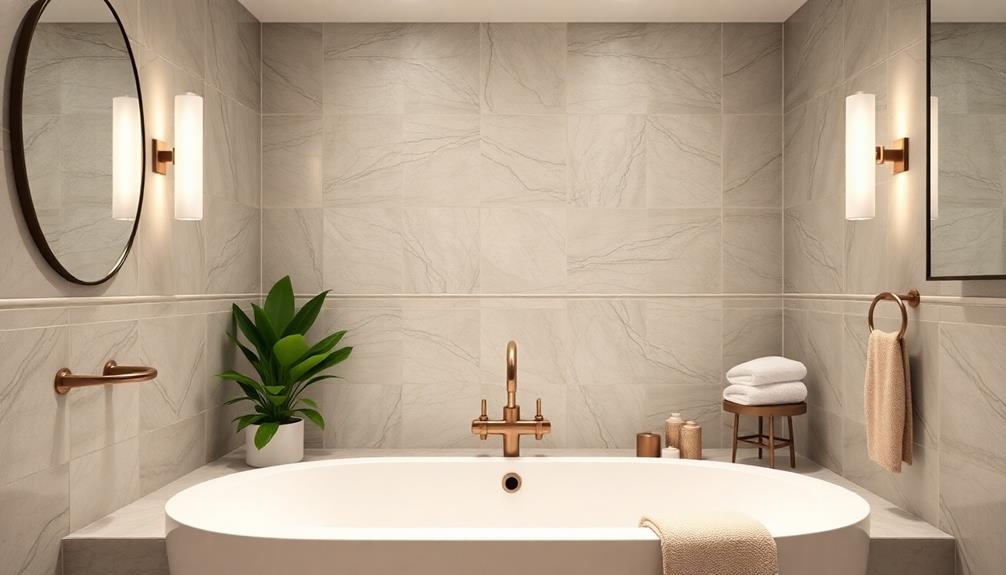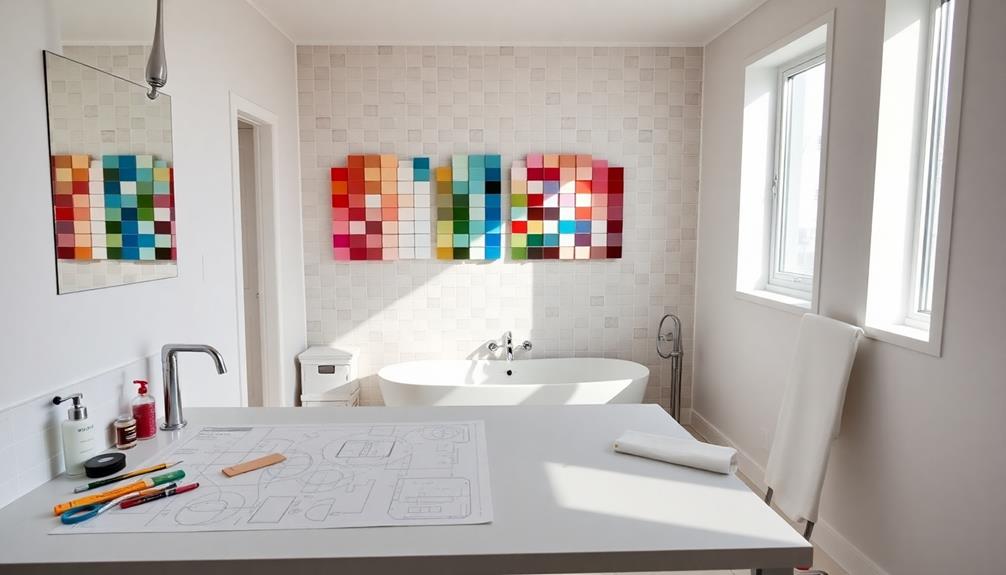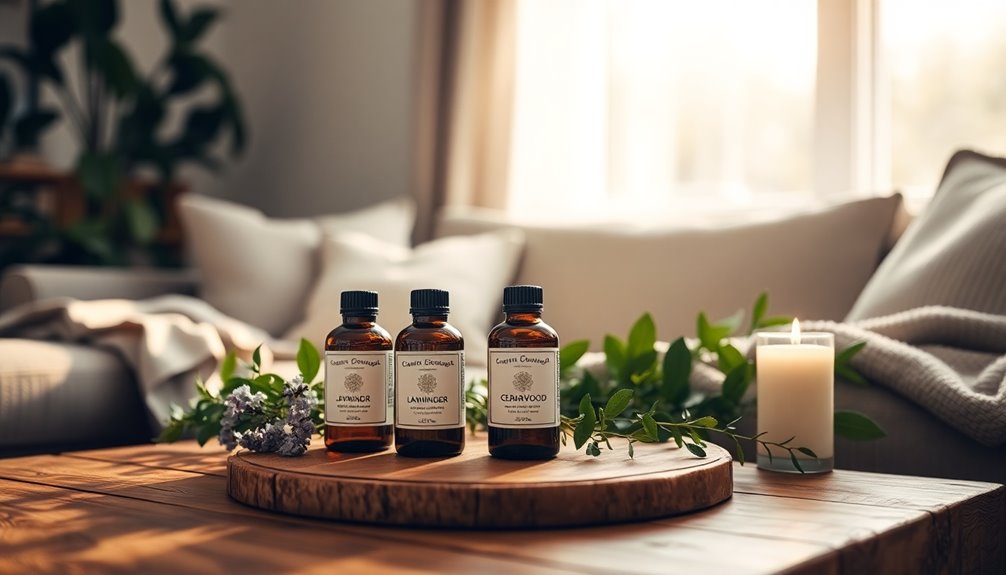To sell a bathroom remodel, you need to highlight the financial benefits and ROI, which sits around 70%. Be strategic with your planning. Use high-quality materials that enhance durability and aesthetic appeal. Maintain clear communication with clients about plumbing and layout options to build trust. Showcase past projects with before-and-after images or 3D renderings to illustrate your capabilities. Actively listen to client needs, allowing for tailored solutions. Finally, emphasize how modern, cohesive designs can maximize resale value. By focusing on these areas, you’ll be well-prepared to attract clients and seal the deal. There’s even more you can explore. Consider offering small bathroom remodel ideas to demonstrate your versatility and ability to work within different constraints. Highlight the potential for creating a luxurious and functional space even with limited square footage. By showcasing your expertise in both large and small projects, you can cater to a wider range of clients and further establish your expertise in the industry.
Key Takeaways
- Highlight the average 70% ROI of bathroom remodels, emphasizing financial benefits to attract budget-conscious clients.
- Use visual aids like 3D renderings and before-and-after photos to showcase your design capabilities and past successes.
- Foster trust through active listening, ensuring you understand client needs and priorities for tailored solutions.
- Present itemized estimates for transparency, allowing clients to compare quality and make informed decisions about materials and costs.
- Showcase testimonials from satisfied clients to enhance credibility and demonstrate your expertise in bathroom remodels.
Financial Considerations
When planning a bathroom remodel, understanding the financial considerations is fundamental. The average return on investment (ROI) for mid-range bathroom remodeling hovers around 70%, which is slightly less than kitchens and siding at 80%. For a home valued at $250,000, you should aim to keep renovation costs between $12,500 and $25,000—about 5-10% of the home's total value.
Additionally, just as one should consider diversification in investments, allocating a portion of your home improvement budget towards high-quality materials can enhance the longevity and appeal of your remodel. This approach can yield better overall returns, similar to how gold IRAs can protect against inflation and market downturns.
To guarantee you're making informed decisions, itemized estimates are essential. They allow you to compare market-value offers with lower bids, helping you spot potential compromises on quality. While it might be tempting to go for the lowest price, be cautious—these lower bids often indicate cost-cutting measures that could compromise the overall quality of your remodel.
Transparency in budget discussions is critical. By showcasing your expertise and being open about costs, you build trust with clients, making them more comfortable with financial considerations.
Ultimately, a well-planned budget not only enhances the bathroom remodeling process but also sets realistic expectations for you and your clients, leading to a successful project.
Plumbing and Layout Strategies

A successful bathroom remodel hinges on effective plumbing and layout strategies. When planning your remodel, try to keep existing plumbing in place whenever possible. Relocating plumbing can greatly hike your costs, adding over $1,500 per fixture for new pipes and possibly up to $10,000 just for moving the vent stack.
Individuals with BPD often experience intense emotional responses to changes in their environment, making it essential to manage expectations during a remodel.
Be aware that ambitious layout changes can lead to budget overruns, so it's important to understand the financial implications of any alterations. Clear communication about how layout changes affect both functionality and budget is essential. Itemized estimates outlining plumbing and layout changes can help you grasp the costs involved, enabling you to make informed decisions.
When working with contractors, foster trust by discussing the plumbing layout openly. This guarantees everyone is on the same page and helps avoid surprises down the line.
Material Selection Tips

When selecting materials for a bathroom remodel, you need to balance durability with aesthetics.
Consider using moisture-resistant options to prevent mold growth, as bathrooms are often exposed to high humidity levels. High-quality options not only enhance the look but also stand the test of time, saving you money on replacements.
Additionally, think about the importance of maintaining a clean environment, similar to how air quality considerations can influence your overall health.
Keep functionality in mind, ensuring that your choices meet both the design vision and practical needs of the space.
Choosing Durable Materials
Choosing durable materials is essential for a successful bathroom remodel, as they directly impact both functionality and aesthetics. You should opt for brass faucets instead of zinc-alloy options, as brass is more resistant to corrosion and offers a longer lifespan for your fixtures.
When selecting tiles, consider textured surfaces and matte finishes; these not only enhance safety by reducing slip risks but also align with CDC recommendations to prevent accidents. Additionally, incorporating budget planning into your remodel can help you make informed choices about material quality without overspending.
If you're planning for an indoor spa, pay close attention to weight and humidity issues. Verify that the materials you choose can withstand these conditions without compromising safety. High-quality ceramic or porcelain tiles are excellent choices, offering versatility and low maintenance while thriving in high-moisture environments.
Additionally, consider incorporating eco-friendly materials like sustainable wood for cabinetry. These durable materials not only enhance longevity but also reflect your commitment to environmental responsibility.
Aesthetic Versus Functionality
Balancing aesthetics and functionality is essential in material selection for your bathroom remodel. When you're choosing materials, prioritize textured tiles and matte finishes. These options not only enhance the design but also notably reduce slip and fall risks, addressing safety concerns highlighted by CDC data.
Additionally, opting for energy-efficient fixtures can contribute to long-term savings, similar to energy-efficient models that reduce heating and cooling costs.
Opt for durable materials to guarantee longevity. Brass faucets are a smart choice, while zinc-alloy fixtures may corrode over time, compromising both their look and function.
If you're considering an indoor spa, think about the weight and humidity factors, and select materials that can withstand these challenges for peak performance.
Incorporating eco-friendly products, like low-flow toilets and faucets, can elevate the functionality of your bathroom renovation. These features appeal to environmentally-conscious buyers and contribute to sustainable living.
Don't underestimate the impact of quality finishes. Natural stone countertops not only boost aesthetic appeal but also offer durability and ease of maintenance—making them a wise investment for resale value.
Effective Sales Techniques

Effective sales techniques are vital for successfully selling a bathroom remodel. Start by tailoring your sales pitch to each client. Ask relevant questions to understand their budget, time frame, and vision for the project. This approach guarantees you address their specific needs and builds trust from the beginning.
Additionally, showcasing your coffee entrepreneurship skills can demonstrate your ability to manage projects effectively and cater to client desires.
Utilizing visual aids like 3D renderings and a strong portfolio of previous work can further illustrate your capabilities in bathroom remodels. Showcasing your past successes helps clients envision the possibilities for their own spaces.
Also, emphasize the financial benefits of renovations. Highlight that bathroom remodels can yield an average ROI of 70%, making them a smart investment for homeowners.
Additionally, invest in continuous sales training to refine your techniques. Ongoing professional development enhances your ability to close deals and adapt to various client scenarios.
Remember, effective listening techniques are vital; allow clients to express their wants and needs without interruptions. This fosters a positive rapport, making clients feel valued and understood.
Importance of Client Listening

Listening to your clients is essential for understanding their priorities and needs. By practicing active listening techniques, you can build trust and create an open dialogue that leads to tailored solutions.
This approach not only enhances satisfaction but also fosters a collaborative atmosphere for successful bathroom remodels.
Additionally, employing strategies for effective communication can help address any concerns clients may have, ensuring that their expectations are met throughout the remodeling process, similar to how financial considerations for elderly care require thorough understanding and planning.
Active Listening Techniques
One of the most vital skills you can develop in the bathroom remodeling business is active listening. This technique allows you to fully grasp your client's wants and needs, which is essential for tailoring proposals that resonate with their vision.
By engaging in active listening, you can uncover underlying concerns or desires that clients mightn't initially express. This is similar to how employers conduct background checks to identify potential issues in a candidate's history, ultimately leading to a better understanding of what's needed for success. This leads to more effective communication and helps build trust.
When you let clients share their ideas without interruption, you create an open dialogue that encourages collaboration. This guarantees alignment on project goals and fosters a positive working relationship.
Remember to ask relevant follow-up questions based on what they say; this shows you're attentive and genuinely invested in their project.
Utilizing these active listening techniques can greatly add value to your client interactions. When clients feel heard and understood, their satisfaction increases, leading to positive referrals and repeat business in this competitive market.
Understanding Client Priorities
Client priorities play a significant role in the success of a bathroom remodel. When you actively listen to your clients, you can identify their needs and guarantee the renovation aligns with their vision.
Start by asking relevant questions about their budget, design preferences, and desired features. This fosters open dialogue, encouraging them to share their expectations, which ultimately leads to better service. Additionally, understanding their lifestyle can help you recommend energy-efficient appliances that align with their goals, such as those that emphasize smart home integration.
Understanding client priorities also involves recognizing their research levels. Tailor your discussions to meet them where they are, avoiding overwhelming technical jargon. This approach builds trust and confidence.
Additionally, listen closely to the emotional connections they wish to create in the space; perhaps they want luxurious features like heated floors or modern fixtures that resonate with them.
Engaging in active listening throughout the project not only showcases your professionalism but strengthens the client-contractor relationship. This can lead to potential referrals and repeat business.
Building Trust Through Dialogue
Building trust with your clients hinges on effective dialogue that encourages open communication. When you listen to their needs, you're not just gathering information; you're fostering a relationship that leads to a better understanding of their desires and expectations for the bathroom remodel. This understanding is essential for a successful project, similar to how trusting instincts can safeguard against emotional pain in relationships.
Engaging clients in a conversation without overwhelming them with technical jargon helps build rapport. It makes them feel comfortable discussing their ideas and budget. Allow them to express their thoughts without interruptions, which shows respect and encourages them to share their vision more freely.
Asking relevant questions about their budget, time frame, and project vision shows your genuine interest in their needs. This approach helps you tailor your strategy to meet their specific requirements.
Showcasing Past Projects

When showcasing past projects, using before-and-after images can powerfully illustrate the transformation of your work, capturing potential clients' attention. This visual storytelling builds trust and interest by demonstrating your skills in kitchen and bath remodels. Highlight specific features like modern fixtures or unique tile designs to help potential clients envision what's possible for their own spaces.
Incorporating 3D renderings along with completed project photos gives clients insight into your design process and capabilities. Testimonials from satisfied clients can further enhance your credibility, demonstrating your expertise in delivering successful renovations. A well-organized portfolio showcasing a variety of styles and budgets caters to diverse client needs.
Here's a simple table layout to illustrate some past projects:
| Project Name | Style | Budget Range |
|---|---|---|
| Modern Oasis | Contemporary | $15,000 – $25,000 |
| Classic Retreat | Traditional | $10,000 – $20,000 |
| Urban Chic | Industrial | $20,000 – $30,000 |
| Coastal Escape | Beachy | $12,000 – $22,000 |
| Luxe Spa | Luxury | $30,000 – $50,000 |
Showcasing this variety appeals to different tastes and budgets, enhancing your marketability.
Maximizing Resale Value

Showcasing your past projects not only highlights your skills but also sets the stage for discussing how a bathroom remodel can maximize resale value. A well-executed bathroom remodel can yield an average ROI of 70%, making it a smart investment.
To attract potential buyers, focus on key updates like modern fixtures, fresh paint, and stylish tiles. These enhancements greatly boost both aesthetic appeal and functionality.
Consider incorporating updated plumbing fixtures, high-quality vanities, and energy-efficient windows—features that can make your bathroom stand out and lead to higher offers during resale. Don't overlook strategic renovations; adding storage solutions and maximizing space efficiency address common buyer concerns and can expedite the selling process.
Moreover, homes with multiple updated bathrooms are increasingly desirable, especially for families. By ensuring your kitchen and bathroom are both modernized, you cater to a broader audience, enhancing overall property functionality.
Keep in mind that a cohesive design between these two areas can create a seamless flow in your home, further increasing its marketability. In the end, a thoughtful bathroom remodel not only elevates your space but also maximizes your resale potential.
Frequently Asked Questions
How Do I Get the Most Value Out of My Bathroom Renovation?
To maximize value from your bathroom renovation, focus on essential updates like fixtures and tiles, embrace modern trends, and stick to a budget of 5-10% of your home's value for the best return on investment.
Is It Worth Remodeling a Bathroom Before Selling?
Yes, remodeling a bathroom before selling's definitely worth it. You'll enhance your home's appeal, attract more buyers, and likely recoup a significant portion of your investment. Updated spaces make a lasting impression on potential buyers.
How to Market a Bathroom Remodeling Business?
To market your bathroom remodeling business, showcase high-quality visuals, leverage social media for testimonials, create informative content, and attend local events. These strategies build trust and attract potential clients enthusiastic for your expertise.
How Much Does a Renovated Bathroom Add to House Value?
Ever wondered how much a renovated bathroom boosts your home's value? Typically, it can recoup about 70% of costs, attracting buyers with modern fixtures and fresh aesthetics, making your property more appealing and easier to sell.
Conclusion
Selling a bathroom remodel is like crafting a beautiful mosaic; each piece matters. By focusing on financial considerations, plumbing strategies, and material selection, you can create a compelling story for your clients. Employ effective sales techniques while listening to their needs, showcasing past projects as proof of your skills. Ultimately, you'll not only enhance their space but also maximize its resale value. With the right approach, you can turn their vision into reality and make a lasting impression.









